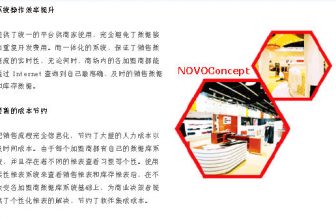
Shopping mall location service application case-real-time positioning based on Wi-Fi
[ad_1]
1.1 Project background:Shanghai Raffles City Positioning
Nowadays, shopping malls are distributed in all corners of the city, and the differentiation between shopping malls is not obvious, and there is no particular advantage for cultivating customer loyalty. While competing in the shopping environment, the deployment of free Wi-Fi in shopping malls has also become a trend. How to use the advantages of shopping mall Wi-Fi to improve the competitiveness of shopping malls is a common consideration for merchants.
There are a large number of stores in the mall. After entering the mall, customers are not familiar with the various stores in the mall. They often spend a lot of time looking for businesses. After entering the store, they don’t understand the store’s promotional information, new product introductions, etc., and the shopping and consumption efficiency is not efficient. high. In addition, large shopping malls are often accompanied by large underground parking garages. How to quickly and conveniently find their own car after enjoying shopping is also a headache for major shopping malls.

Uber’s LBS solution for shopping malls is based on indoor Wi-Fi RTLS technology, which has accumulated many years of indoor Wi-Fi RTLSBased on experience, the program specially created for shopping malls can effectively solve the above problems, create a modern and warm shopping environment for businesses, and win more customers.
1.2 Description of requirements
Wi-Fi coverage: Nowadays, customers have more and more Wi-Fi smart devices and they can carry them at any time. After entering the mall, facing the many needs of customers, it is necessary to deploy free Wi-Fi signals in the mall to allow customers to spend their time while shopping Enjoy free Wi-Fi surfing.
Store shopping guide: When customers enter the mall, facing the huge mall and the overwhelming product information, the merchant needs to provide customer path guidance. After the customer enters the destination, it can intuitively guide the customer to the destination in real time.
Public information: When customers enter the perimeter of the mall, including the interior, the mall needs to push some public information about the mall to past guests to attract customers to enter the mall for shopping.
Commodity information: How to quickly and effectively inform customers of the new products and services in the store, and how to quickly and automatically obtain the latest product information and discounts of the store after entering a certain store, we need to establish a business information promotion platform.
Crowd flow statistics: It is necessary to be able to count the daily flow of people in a specific area or store, as well as the stay time and other information, so as to scientifically manage the store and provide scientific data for the marketing direction of the merchant.
Car-finding service: After shopping, customers often carry a lot of goods. At this time, they need to find their car in the shortest time and finish shopping. How to improve fast and accurate car-finding service.
Location-based content services: Shopping malls need to develop corresponding mobile clients to cultivate customer loyalty through points or other means, and corresponding interfaces of the positioning system are needed to call relevant location information.
1.3 Demand analysis
1.3.1 Performance requirements of wireless positioning system:
To achieve mobile positioning, that is, to locate the mobile personnel in the mall, it is required to minimize the positioning delay to ensure the real-time performance of the system.
The general positioning accuracy is required to be controlled within the range of 10-20 meters, and the accuracy of individual areas can reach 3-5 meters.
It can be interconnected with the shopping mall APP system platform to achieve coordination between multiple systems.
Method to realize:
Smartphones can be positioned by installing or not installing software, the difference is as follows:
No software installation: AP needs to use U-band or the AP locator specified by U-band to achieve positioning.
Install software: AP can realize positioning function by using U-band or ordinary AP.
1.3.2 Based on the above analysis, the LBS system of Youpin Mall provides the following functions:
Wi-Fi Internet access: After achieving full Wi-Fi coverage in the mall, customers can use Wi-Fi to surf the Internet for free when visiting shopping stores.
Customer positioning: When a user using a location service walks into the mall, the location software of the Wi-Fi device can display the location of the user, and the user can know his location through the Wi-Fi terminal query function, the specific location of a certain business, and pass Route guidance provides services.
Information push: There are a large number of stores in shopping malls. When a user holds a Wi-Fi terminal and passes by a store, the system platform will push advertisements, new products, discounts and other preferential information to the smart terminal according to the store where the user is located. When the user opens the browsing, if he is interested in a certain advertisement, he can call up the detailed product information for browsing through the handheld query terminal, and provide corresponding route guidance services.
Indoor navigation: Users can obtain real-time product information through their own Wi-Fi terminals (including Wi-Fi phones, tablets, notebooks, and PDAs). And Wi-Fi handheld devices can query business information and related walking routes of interest at any time, as well as user location information services.
Passenger flow statistics: Display or export customer data for a specified time period and channel in a variety of intuitive chart forms, and connect with the cash register system to realize conversion rate statistics and provide objective data support for management decision-making.
Self-service car search: Customers can enjoy free self-parking and car search services through the mall APP. In the huge parking lot, after clicking the car search button on the mobile phone, the path to the parking space is automatically generated according to the location of the person, and the customer is guided.
Electronic patrol: There are a group of dedicated property management and security personnel in the mall. They can obtain the location information of the property and security personnel through Wi-Fi positioning, and record the patrol routes and conditions of the patrol personnel through the wireless positioning system, and Display in the background management software. In this way, regular patrols and cleaning staff in the shopping mall, including their workload statistics can be realized, so as to carry out scientific and effective management.
APP development: Provide corresponding API interfaces for customers to call related data to develop corresponding APP applications.
1.4 Program advantages
Wi-Fi network coverage is wide, easy to cover the entire area, equipment can be centrally managed, and maintenance costs are low;
GPS cannot work indoors;
Other non-Wi-Fi positioning technologies must be networked separately, and mobile phones cannot be located directly;
It can locate mobile phones, tablets, PDAs and other terminals with Wi-Fi, as long as you turn on Wi-Fi and use the mall APP, you can locate;
Using wireless signal fingerprint algorithm combined with historical trajectory and auxiliary antenna, and using actual environment model to consider factors such as human body interference, the actual positioning accuracy is high, which can reach 3-5 meters;
The traditional Wi-Fi-based triangulation algorithm positioning is interfered by the environment and the human body, and it is impossible to achieve precise positioning stably;
Positioning AP does not affect Wi-Fi data transmission, so positioning AP can be deployed very densely to improve positioning accuracy;
However, the APs of general AP manufacturers will frequently transmit signals, so the deployment density cannot be achieved;
A single positioning AP can collect 256 terminal positions within 1 second, and the positioning engine can calculate 500-1000 positions within 1 second, and the positioning engine can be expanded to support tens of thousands of positioning terminals;
Some successful cases: Shanghai Putuo Detention Center, Yangzhou Detention Center, Inner Mongolia Prison, Zhejiang Women’s Prison, Jilin Baishan Power Station, Hong Kong Tunnel, and a chemical plant in Gansu;
1.5 System composition
System composition:
APLocator: The locator collects Wi-Fi terminal information and sends the information to the background location server.
Wi-Fi terminal (HandheldTerminal): Wi-Fi terminals periodically transmit Wi-Fi signals, and the signals include a unique MACID. The Wi-Fi terminal is bound to the customer. The background system binds the Wi-Fi terminal’s signal ID and customer name and other information.
Locating Server: The locating server contains three locating engine servers, IIS servers, and database servers, which can calculate the location based on the signal.
Content Server: The content server supports information content related to the exhibits and user information.These functions require secondary development
work process:
The user holds a hand-held Wi-Fi terminal, the Wi-Fi terminal turns on Wi-Fi, and regularly sends out relevant information about itself
At the same time, the AP locator collects relevant data and forwards it to the positioning server.
The positioning server determines the approximate distance from the merchant based on the ID and signal strength of the positioning terminal. When the handheld terminal is about 3-5 meters away from the merchant, the handheld terminal triggers the push program.
The location server obtains the information of the handheld terminal and the location tag, calculates the location of the device or tag, and sends the device ID, location information, etc. to the content server.
The content server sends relevant content to the terminal device in real time according to the location, and can interact with the terminal device in real time.
1.6 Handheld terminal function description
Combined with the personalized application of the mall, secondary development is required:
According to the current position, play multimedia information, video, FLASH, recording and display text. The multimedia content is bound to the location in advance and stored on the content server. The content server is triggered by the location to choose which push information to play where.
The user clicks on the “current location” to pop up the location map, and mark it on the map according to the coordinates. The user can manually refresh the location, and the map can update the location indicator.
Users can search for a certain type or a certain business, the map shows the location, and provides walking directions.
Users can connect to the Internet to browse more content.
1.7 LBS system function description
Wi-Fi coverage: Deploy wireless APs in shopping malls to achieve seamless coverage and meet the needs of wireless Internet access.
Location services: real-time positioning
Display the icon of customers carrying Wi-Fi handheld devices on the electronic map;
The current location of the portable Wi-Fi handheld device is displayed on the map;
During the positioning process, you can see the smooth movement of the icon in real time, and the map will automatically switch with the movement of the person;
You can manually switch the map to view the activity of all tags on the specified map;
The map supports zoom in and zoom out, and adjust to a suitable size;
Track playback
The movement track can be played according to the time period, and the map can be automatically switched;
Support full screen, fast, backward and other playback modes;
Information service
Active marketing: When customers enter the mall, the system will push nearby shopping information in real time according to the floor or specific business;
Precision marketing: The system automatically sends similar product information based on the customer’s past shopping experience or products of interest;
Self-service query: Customers in the mall can query nearby new products, discounts, promotions and other preferential information in real time;
The discount information is displayed on the map, and the user can click to browse the detailed content;
E-member
Through the customer’s mobile phone ID, apply for membership for the customer, instead of the traditional membership card, the customer can travel easily;
When a customer walks into the store, the salesperson immediately knows whether the customer has been there, how many times he has been there, and the time of the last visit, and can conduct targeted shopping guides;
The store installs the shopping map APP for customers’ mobile phones, develops members, and can push promotional information in the future;
Real-time shopping guide
Users can self-check surrounding product information, and the system will automatically plan a reasonable route and display it on the map, similar to GPS navigation;
Facing the preferential information obtained by the Wi-Fi device, if you need to go, the system will provide the way to go;
Self-service car search
After the customer parks the car, click the parking button of the mall APP, and the system will record the parking location;
After shopping, click the car search button, and the system will automatically generate the quickest car search path according to your location and parking location;
Passenger flow statistics
Accurate statistics can be made on the flow of people in the designated area, and the flow of people in different directions can be counted separately, and the number of people can be counted.
It can realize the statistics of the flow of people at a single entrance and exit, and it can also realize the statistical analysis of the flow of people at multiple entrances.
Through the supporting professional passenger flow analysis software, the number of people statistics data is analyzed and graphs are generated, and a variety of data analysis graphs are generated according to the set conditions, such as setting: minute, hour, day, week, month, year and other time condition production reports; Reports can also be generated according to conditions such as weather, festivals, and promotional activities.
Real-time video recording, storage, retrieval, and video playback viewing can be performed on the video screen of the human flow analysis.
The entire system is networked. People flow data, passenger flow analysis reports, video data, etc. can be remotely searched and retrieved through the network. Enterprise managers can learn about the passenger flow status of the supermarket through the network in a remote place, which is convenient, fast and efficient.
APP development
The system provides corresponding API interfaces for customers to call related data to develop corresponding APP applications.
[ad_2]






